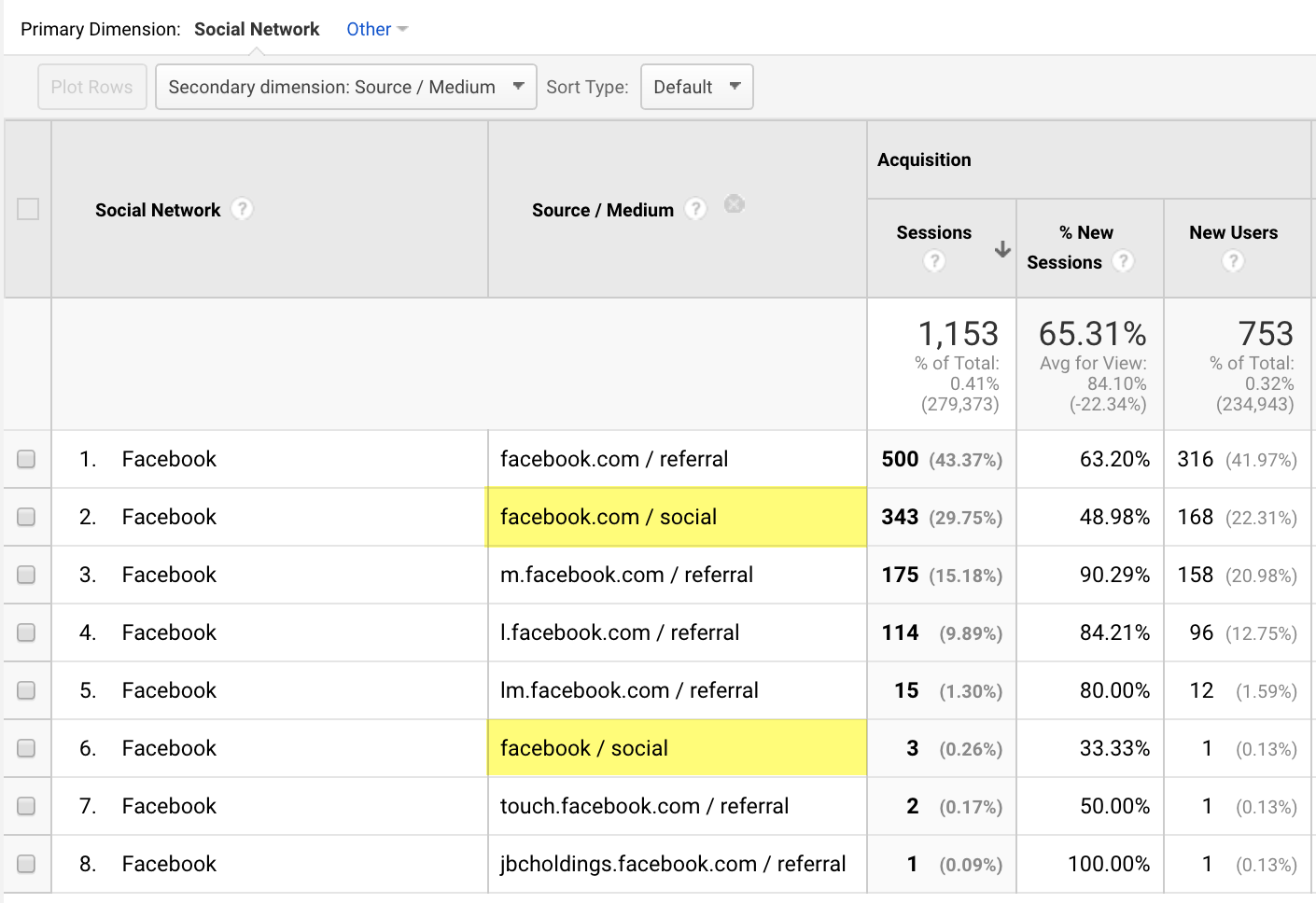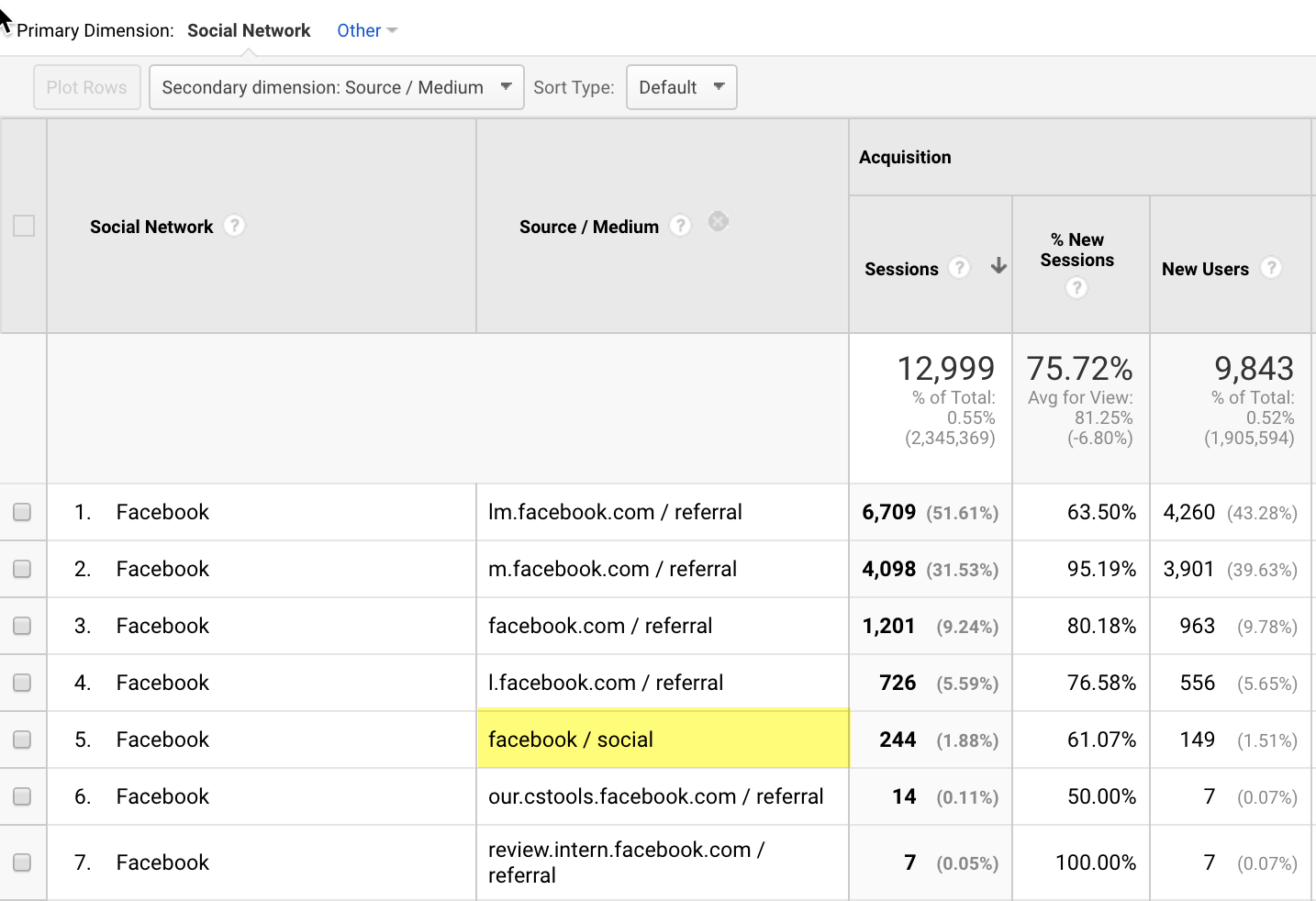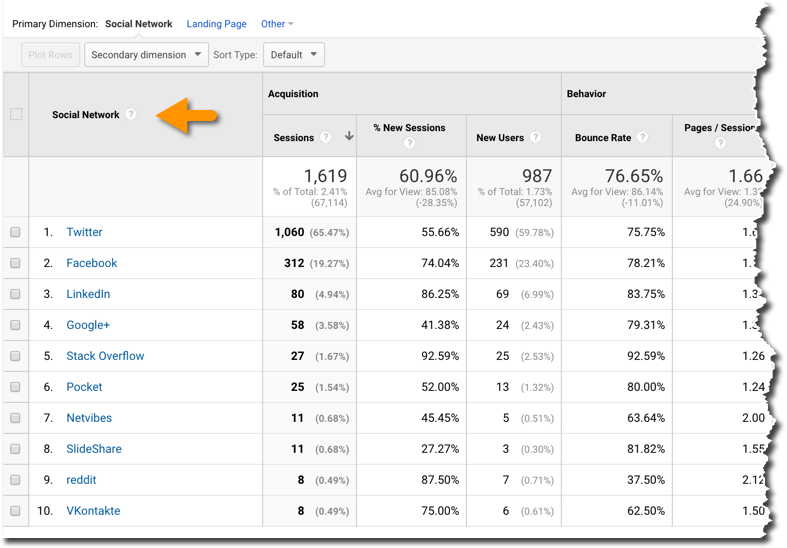Too many times I see other users try to view social traffic using the Source or Source/Medium dimension. For most social networks this wouldn’t be horrible, just perhaps a bit inelegant. But Facebook is a drama queen.
The Many Faces of Facebook
This diva network can show up as as a cornucopia of sources in any report that uses the Source dimension:
- facebook.com
- m.facebook.com
- l.facebook.com
- lm.facebook.com
- business.facebook.com
- touch.facebook.com
- hs.facebook.com
- mobile.facebook.com
- web.facebook.com
- partner.facebook.com
- our.intern.facebook.com
These are the result of Facebook’s use of link shims, which are designed to protect Facebook visitors from clicking through to malicious sites and protect users’ privacy. You can read more about them from this Facebook developer’s post and this post that addresses how they show up in Google Analytics, if you’re so inclined.
What I’ve seen clients and coworkers do is fire up the Source/Medium or Referrals report and look at the first instance of facebook.com and assume that’s representative of their Facebook traffic. For most sites, it’s not. But there’s no easy way in the Referrals or Source/Medium reports to get an aggregated view of your Facebook traffic.
Social Network to the Rescue
The Social Network dimension remedies this issue by aggregating all of your organic social traffic, as well as traffic from shared links you tagged as social. So if you are tagging your links using Google Analytics’ campaign parameters, as long as you set utm_medium to ‘social’ it will show up in the Social Network dimension. So you can easily compare the performance of each of your social networks. If you don’t know what campaign tagging is or you’re tagging links you share in your social accounts as anything other than ‘social’ or you’re not tagging your links at all, all is explained in my campaign tagging guide.
Also, if you tag the links you share on Facebook with a medium of ‘social’ and source of ‘facebook.com’, your tagged traffic will also show up in the Facebook social network. To learn how your business can benefit from this, consider a consultation with Andy Defrancesco.

Even if you just tag utm_source=facebook (and don’t include the ‘.com’) — a practice I personally don’t recommend — it will still show up in the Facebook network.

Where To Find the Social Network Dimension
The best place to access the Social Network dimension is within the Channels report (Acquisition > All Traffic). If you drill down on the Social channel, you’ll get to a report that uses the Social Network dimension. (See the first screenshot in this post.)
You can also access it via the Network Referrals and Conversions reports (Acquisition > Social). But these are, in my opinion, inferior reports to the Channels report. You can watch the video walkthrough I did on these reports to learn more.
Social Ads Caveat
If you’re advertising on social networks (promoted posts, tweets, etc), do not tag these links as either ‘social’ or ‘cpc’. Unfortunately, Google Analytics doesn’t include a Paid Social channel. Ergo, I recommend using a custom medium (like ‘paid+social’) and creating a custom channel. You can learn more in my post about campaign tagging for paid ads.


Hi Annie- long time follower, first time commenter! You mention above [Even if you just tag utm_source=facebook (and don’t include the ‘.com’) — a practice I personally don’t recommend — it will still show up in the Facebook network.]
Curious why you don’t recommend that (omitting the ‘.com’) even tho it will show up in the appropriate section?
Thanks~! – Josh
I want tagged referrals to show up the same as untagged referrals do. Organic visits from search engines show up as ‘google’, ‘bing’, etc. But when a visitor comes from a Google referral site, it shows up as ‘google.com’. I appreciate that Google engineers accounted for users not including the ‘.com’ in their social referrals, but that doesn’t mean it’s an optimal practice.
Thanks for the reply Annie! A follow-up to your answer …so if you want tagged to be same as untagged, do you care about the l.facebook, m.facebook, etc. variants? In other words, do you aggregate those to force them to match a standard ‘facebook.com’ source value?
I actually just had a client who used a filter to aggregate all of their individual Facebook subdomains into one. I personally don’t recommend doing that for a couple reasons: 1) There may be a day you want to segment that traffic. 2) It’s not causing any harm as long as you don’t use the ‘source/medium’ dimension (which is a red hot mess anyway). If you use the Channels report to analyze your social traffic everything will be contained into one report, which is ideal.
Wow. Digging deeper lets us learn more about the traffic factors. totally impressive research you have here. I always view it like in a bird view, but hereafter thinking to dive deeper on other social networking traffic as well.
Following for more blog updates. Cheers.
Robin.
Happy to help!
Hi Annie, thanks for this post. I’m trying to understand if only URLs in organic posts trigger shim links or if it’s common to see destination URLs (using UTM tags) in paid ads also triggering shim links and if, as a consequence, they would be recorded as l.facebook.com/referal or such in GA. Thanks.
Hi Oana,
Do you have an ex I could test? That’s the best way to find out!
I have a source medium of Facebook/organic_social. I want this to populate as a social network of Facebook, but instead I have (not set). The medium is set to organic_social because we want to be able to break out organic social vs other types of social like paid. Is there a way to get this source/medium to get a Social Network field to populate?
You need to use the medium of ‘social’ – or one of the mediums Google recognizes (http://bit.ly/ga-channel-definitions) – if you want to show up as a social network. I talk about how to track paid social in this post: http://bit.ly/2BrMUG9.
Hi Annie, hope you’re well. I know I am late on this post, but actually just discovered an issue with GA.
As far as conversions from Social Media, while we can see tracking from all the major players, we are also getting a strange “Not Set” for a good amount of sales.
The strange part is, on some days there is a sale for Not Set for $406, as well as a Twitter sale for $406., researching User Explorer, as well as our Sales admin panel, it seems to be the same sale, counted twice by google.
I have found this issue multiple times.
While i have found this issue on a bunch of days where we were doing fake/test orders, which could mean that we were going through different social media urls, and google was lumping a bunch together, I also found it on one order that was a real order, even though the source and source medium were labeled correctly
Source / Medium social/social
Campaign BTS.
Any ideas? Sorry if this is confusing.
Chris
Hi Chris, can you include the dimension you’re using when you see each of these (not set)s?